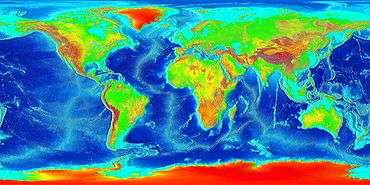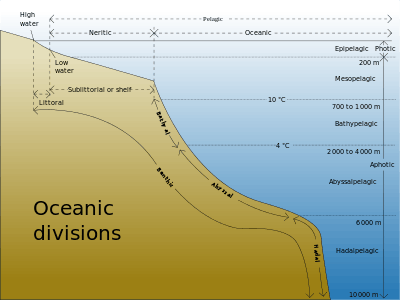Seabed

The seabed (also known as the seafloor, sea floor, or ocean floor) is the bottom of the ocean.
Seabed structure

Most of the oceans have a common structure, created by common physical phenomena, mainly from tectonic movement, and sediment from various sources. The structure of the oceans, starting with the continents, begins usually with a continental shelf, continues to the continental slope – which is a steep descent into the ocean, until reaching the abyssal plain – a topographic plain, the beginning of the seabed, and its main area. The border between the continental slope and the abyssal plain usually has a more gradual descent, and is called the continental rise, which is caused by sediment cascading down the continental slope.
The mid-ocean ridge, as its name implies, is a mountainous rise through the middle of all the oceans, between the continents. Typically a rift runs along the edge of this ridge. Along tectonic plate edges there are typically oceanic trenches – deep valleys, created by the mantle circulation movement from the mid-ocean mountain ridge to the oceanic trench.
Hotspot volcanic island ridges are created by volcanic activity, erupting periodically, as the tectonic plates pass over a hotspot. In areas with volcanic activity and in the oceanic trenches there are hydrothermal vents – releasing high pressure and extremely hot water and chemicals into the typically freezing water around it.
Deep ocean water is divided into layers or zones, each with typical features of salinity, pressure, temperature and marine life, according to their depth. Lying along the top of the abyssal plain is the abyssal zone, whose lower boundary lies at about 6,000 m (20,000 ft). The hadal zone – which includes the oceanic trenches, lies between 6,000–11,000 metres (20,000–36,000 ft) and is the deepest oceanic zone.
Technical terms
The acronym "mbsf" meaning "meters below the seafloor" is a convention used for depths below the seafloor.[1][2]
Benthos
Benthos is the community of organisms which live on, in, or near the seabed, the area known as the benthic zone.[3] This community lives in or near marine sedimentary environments, from tidal pools along the foreshore, out to the continental shelf, and then down to the abyssal depths. The benthic zone is the ecological region on, in and immediately above the seabed, including the sediment surface and some sub-surface layers. Benthos generally live in close relationship with the substrate bottom, and many such organisms are permanently attached to the bottom. The superficial layer of the soil lining the given body of water, the benthic boundary layer, is an integral part of the benthic zone, and greatly influences the biological activity which takes place there. Examples of contact soil layers include sand bottoms, rocky outcrops, coral, and bay mud.
Seabed features

Each area of the seabed has typical features such as common soil composition, typical topography, salinity of water layers above it, marine life, magnetic direction of rocks, and sedimentation.
Seabed topography is flat where sedimentation is heavy and covers the tectonic features. Sediments comes from various sources:
- Land erosion sediments, brought mainly by rivers
- Underwater volcanic ash spreading, especially from hydrothermal vents
- Microorganism activity
- Sea currents eroding the seabed itself
- Marine life: corals, fish, algae, crabs, marine plants and other biologically created sediment
Where sedimentation is very light, such as in the Atlantic ocean, especially in the northern and eastern Atlantic, the original tectonic activity can be clearly seen as straight line "cracks" or "vents" thousands of kilometers long.
Marine life is abundant in the deep sea, especially around hydrothermal vents. Large deep sea communities of marine life have been discovered around black and white smokers—vents emitting chemicals toxic to humans and most vertebrates. This marine life receives its energy both from the extreme temperature difference (typically a drop of 150 degrees) and from chemosynthesis by bacteria.
Brine pools are another seabed feature,[4] usually connected to cold seeps.
History of exploration
The seabed has been explored by submersibles such as Alvin and, to some extent, scuba divers with special equipment. The process that continually adds new material to the ocean floor is seafloor spreading and the continental slope. In recent years satellite images show a very clear mapping of the seabed, and are used extensively in the study and exploration of the ocean floor.
Resources
Seabed contains "several hundred years' worth of cobalt and nickel". In 2001-2013 International Seabed Authority issued 13 various licences to seabed mining.[5]
In art and culture
Some children's play songs include elements such as "There's a hole at the bottom of the sea", or "A sailor went to sea... but all that he could see was the bottom of the deep blue sea".
On and under the seabed are archaeological sites of historic interest, such as shipwrecks and sunken towns. This underwater cultural heritage is protected by the UNESCO Convention on the Protection of the Underwater Cultural Heritage. The convention aims at preventing looting and the destruction or loss of historic and cultural information by providing an international legal framework.[6]
Further reading
- Roger Hekinian: Sea Floor Exploration: Scientific Adventures Diving into the Abyss. Springer, 2014. ISBN 978-3-319-03202-3 (print); ISBN 978-3-319-03203-0 (eBook)
- Stéphane Sainson: Electromagnetic Seabed Logging. A new tool for geoscientists. Springer, 2016. ISBN 978-3-319-45353-8 (print); ISBN 978-3-319-45355-2 (eBook)
See also
References
- ↑ Flood, Roger D.; Piper, D.J.W. (1997). "Preface: Depth Below Seafloor Conventions". In Flood; Piper; Klaus, A.; Peterson, L.C. Proceedings of the Ocean Drilling Program, Scientific Results. 155. p. 3. doi:10.2973/odp.proc.sr.155.200.1997.
we follow Ocean Drilling Program (ODP) meters below seafloor (mbsf) convention
- ↑ Parkes, R. John; Henrik Sass (2007). Sulphate-reducing bacteria environmental and engineered systems. Edited by Larry L. Barton University of New Mexico. Sulphate-reducing bacteria environmental and engineered systems. Cambridge University Press. pp. 329–358. doi:10.1017/CBO9780511541490.012. Retrieved 11 June 2010.
metres below the seafloor (mbsf)
- ↑ Benthos from the Census of Antarctic Marine Life website
- ↑ Wefer, Gerold; Billet, David; Hebbeln, Dierk; Jorgensen, Bo Barker; Schlüter, Michael; Weering, Tjeerd C. E. Van (2013-11-11). Ocean Margin Systems. Springer Science & Business Media. ISBN 9783662051276.
- ↑ http://www.bbc.com/news/science-environment-21774447
- ↑ Safeguarding the Underwater Cultural Heritage UNESCO. Retrieved 12 September 2012.
External links
| Look up seabed in Wiktionary, the free dictionary. |
- Understanding the Seafloor presentation from Cosee – the Center for Ocean Sciences Educational Excellence.
- Ocean Explorer (www.oceanexplorer.noaa.gov) – Public outreach site for explorations sponsored by the Office of Ocean Exploration.
- NOAA, Ocean Explorer Gallery, Submarine Ring of Fire 2006 Gallery, Submarine Ring of Fire 2004 Gallery – A rich collection of images, video, audio and podcast.
- NOAA, Ocean Explorer YouTube Channel
- Submarine Ring of Fire, Mariana Arc – Explore the volcanoes of the Mariana Arc, Submarine Ring of Fire.
- Age of the Ocean Floor National Geophysical Data Center
- Astonishing deep sea life on TED (conference)

